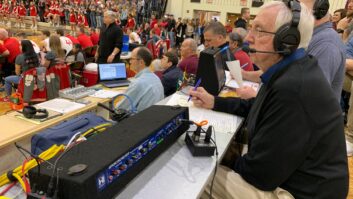When industry pundits focus on problems facing terrestrial radio broadcasting, they tend to emphasize a single issue without creating a language and framework for a larger view. We see details when we look at a terrain from 20 feet, but we can only see the larger pattern from an altitude of 10,000 feet. Both views are important because they each contribute different kinds of information.

iStockphoto/John Woodcock
Details only make sense when considered within the context created by the larger pattern. But on the other hand, a pattern is created by the composite of details and their relationship. As readers may have noticed, my columns tend to focus on the patterns. This is not because details are unimportant but because I happen to be more adept at recognizing patterns.
What then are the larger patterns and what are the key elements that allow us to construct these patterns? In engineering, we call such patterns models. They are intended to focus on some aspects of reality while explicitly ignoring others.
In order to explore the past, present and future patterns in terrestrial radio, I will draw on parallels in related industries to illustrate how different companies and industries respond to the technical and social forces that disrupt the status quo. Radio exists in a much larger media system, and we can only understand radio if we also understand that system.
ELEMENTS IN ALL MEDIA SYSTEMS
I will use a model that is composed of four major elements for examining such industries as radio, television, newspapers, music and online selling. Once having articulated these elements, we are in a position to look at ways in which these elements are implemented and how they are combined to produce an economically viable framework.
Consider the following four classes of elements:
Content Creators:This is where the media content is created, in the form of interviews, music, news, traffic reports and so on. Real people create content using their creativity, labor and capital equipment. Composers create music scores, journalists create news stories and mixing engineers create audio programs. Organizations may contract for content and own the resulting copyright.
Content Aggregators: These are gatherers of content collections. Such content pools have higher value than the sum of the individual pieces because of the economies of scale. Restaurants aggregate multiple types of dinners on their menu; newspapers aggregate news from sports, local events, national politics, financial dynamics and activities around the world. Radio and television networks accumulate a variety of audio and visual media content. Individuals aggregate content on their hard drive and portable media players.
Distribution Service: Once aggregators have collected content, they must transport one or more pieces of content to their end users. Broadcasting is a distribution service. YouTube uses the Internet to distribute its online movies. The most complex and expensive part of the food industry is found in the distribution process: getting food from the farm to the local stores.
Compensation System: This is the element where money is collected to provide compensation for the added value created by the previous three elements. Income must be distributed to each element to support its service. One way or another, all forms of compensation arise from the end user in the form of pay-per-unit, yearly subscription, access to head-space for advertising or government-mandated taxation.
HISTORY DOES NOT REPEAT
Each company chooses how to implement the four elements and decides how they will interact with each other. In the early days of many industries, pioneers needed to invent and implement all four elements. The resulting vertical integration was relatively pure.
Early radio networks owned much of their content in the form of private orchestras, radio theater, news reporters, announcers, studios and equipment. They developed a vast range of program formats. As technology advanced, they accumulated a recorded inventory of program material in their archives. Distribution was implemented through captive transmitters on government-licensed channels. Compensation was exclusively from advertising.
Newspapers were similarly integrated, with captive news reporters, copy editors, printing plants, distribution trucks, local resellers and a sales staff that sold advertising.
Early cinema followed a similar model composed of actors, writers and support staff that performed in private studios to produce films that were distributed to end theaters. These early cinema organizations accumulated a vast library of films; they often developed the specialized equipment required to record and reproduce their content. Individuals provided compensation when they purchased tickets to view movies at local theaters.
These early frameworks constitute the “good old days” of pure vertical organizations.
THE FUTURE IS COMBAT
During the second half of the 20th century, changes in technology and social values undermined the stability of the classical frameworks that were created in the early part of the century. Organizations formed using new elements. Some companies specialized in only one or two elements. This opened up competitive combat between the various frameworks and their models.
We can examine an example of framework combat. Blockbuster and Hollywood Video grew large by distributing movies directly to consumers, thereby creating a profitable supplement to local theaters. They provided VHS tape and, later, DVD aggregation in local stores. Walk-in traffic handled distribution and per unit rental provided compensation.
Netflix appeared in 1997 and effectively destroyed them by replacing walk-in traffic distribution with the U.S. mail; that in turn allowed for greater economies of scale with a larger aggregation in centrally located warehouses. They replaced unit rentals with a subscription model. Somewhat later, the Internet allowed for electronic distribution at no cost, and aggregation was achieved with a hard disk farm that stored only one copy of each DVD.
FRAGMENTATION OF LISTENERS
Politics as well as technology influences fragmentation. By the 1940s, the FCC had adopted rules restricting radio station ownership to prevent monopolies, essentially enforced niches. Five decades later, the FCC relaxed their attitude toward regulation, and with the Telecommunications Act of 1996, Congress eliminated the cap on ownership. As a handful of companies consolidated thousands of radio stations, advertisers could easily reach millions of listeners composed of kids, grandparents, truck drivers and so on.
While the changes in political winds now allowed for truly mass markets, new technology reintroduced customized distribution of media to small groups of individuals with narrow tastes. Niche markets returned. In the limit, the Internet allows a single content creator to be connected to a single listener.
Retail electronics, which was originally designed for computer professionals in the 1970s, had a large impact on radio. Any teenager can become his own content creator, making music and movies in his bedroom. Large hard drives allow anyone to become an aggregator with a customized personal library of thousands of audio-video media. By using Facebook or a personalized Web page, kids have access to world-scale distribution of original content. Their compensation does not require money since they do it for fun and fame. The behavior of these teenagers changes the demographics of radio.
Once fragmented, niche markets begat a variety of compensation models. It is easy to find examples of both the subscription model in the form of all-you-can eat for one price and pay-per-item using Internet download. Advertising became only one part of compensation.
And advertising itself fractured with the addition of such new venues as (a) customized Web page inserts based on geographic location and user search behavior, (b) embedded televisions in your local gasoline pump, (c) product placements permanently embedded in program material, (d) computers sold with built-in advertising, and (e) commercials presented before feature films at local theaters.
THE FUTURE OF RADIO
Why should those of us who work in radio broadcasting care about the business models used in unrelated industries?
The answer is that we are all embedded in a large interactive system. To use an analogy, even if I am only interested in the well-being of zebras in West Africa, I must still consider how lions get their food, how changes in weather patterns influence water supplies, how the economics of safaris changes native habitats, how global transportation distributes pathogens and so on. We are a “global world.” Nothing is independent. Radio is only one component of a much larger system.
Our industry must accept that the landscape is now different, and if we do nothing, our economic viability will gradually be reduced until terrestrial radio is just one of many niche providers.
In the 1990s, when HP CEO Lewis Platt observed that low-cost printers were competing with their very profitable and very expensive office laser printers, he commented: “It’s better to eat your lunch before someone else eats it for you.” And he continues by encouraging preemptive self-destruction and renewal. “We have to be willing to cannibalize what we’re doing today in order to ensure our leadership in the future.” Who will eat our lunch?
Barry Blesser is director of engineering for 25-Seven Systems. Opinions are his own. Comment on this or any article to [email protected].












